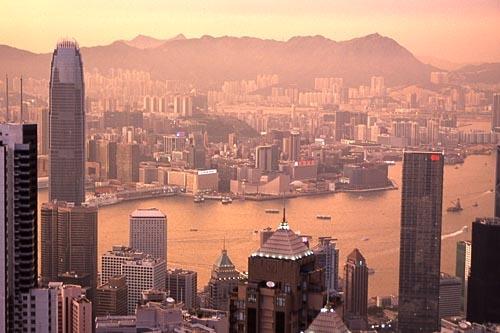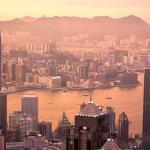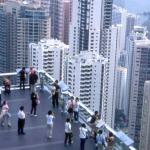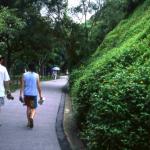Hiking Hong Kong’s Victoria Peak
Whenever I need a quick escape from the urban canyons of Hong Kong, I head up to Victoria Peak, stroll the loop trail that wraps around the flanks of the 1,810-foot (552-meter) mountain, and then hike back down to sea level through Pok Fu Lam Country Park. This easy two-hour jaunt never fails to offer me stunning views of the city, lush green forest, and woodland solitude broken only by the wind in the trees and the call of exotic birds. Amazingly, the Peak is just a 12-minute tram ride away from the international banks and multinational corporations of the high-powered Central business district.
Reaching The Trailhead
Hardcore hikers can trek up to the Peak on foot, but I recommend taking public transport to the top and then hiking back down. Fortunately, Hong Kong's extensive public transportation network makes reaching the Peak both simple and cheap. Most first-time visitors to Hong Kong scale the Peak aboard the Peak Tram. This venerable red funicular climbs the mountain on a track so steeply pitched that at times the tram seems to be heading straight up. Board the tram at the Garden Road terminus in Central. Be sure to buy a one-way ticket for HK$20 (US$2.60), since you will be walking back down. The tram will carry you up to the Peak Tower and Galleria, which sit adjacent to the trailhead.
Taxis offer a more expensive option for reaching the Peak, though like most locals I prefer the cheaper double-decker buses. Catch bus 15 out of Exchange Square for HK$9.20 (US$1.20). Sit in the front row of seats on the top deck for the best views as bus 15 threads its way through the bustling districts of Central and Wan Chai. Eventually the bus turns onto Stubbs Road and starts climbing towards the Peak. On this narrow, twisting cliff road the bus driver performs delicate high-speed ballets with oncoming vehicles. When a dump truck approaches, passing space can be measured in inches. As the bus gains altitude, sweeping vistas open up to reveal the vast sprawl of the city below. Within 30 minutes the bus pulls into the terminal beneath the Peak Galleria shopping mall, opposite the trailhead.
Across from the Peak Galleria is the Peak Tower, a futuristic entertainment center that clings to the side of the slope with about as much grace and beauty as an oil rig. This steel and glass building has been variously described as a giant wok, a massive half moon or a colossal anvil. Still others say it resembles the Chinese character for "profit." The Peak Tower is an acquired taste that I've come to appreciate over time. However, those who never grow to love the tower's strange design can take solace in the low clouds that often hide it from view.
The Peak Tower offers an array of eating options, including the Movenpick Marche restaurant on the top levels. For a quick caffeine fix, try the Pacific Coffee Company with its panoramic views of the ship-speckled harbor. The tower also houses amusement park attractions like Ripley's Believe It or Not, Madame Tussaud's, and the Peak Explorer Motion Simulator. You'll get a real thrill -- as opposed to the artificial ones manufactured in the Motion Simulator -- when you step out onto the free public observation platform, which offers fine views of the harbor, city, and mountainous New Territories. The best views, however, are seen from Lugard Road, the first stage of the Peak circuit trail.
The Peak Circuit Trail
In colonial times the Peak remained the preserve of the city's British elite, who built villas atop the mountain to take advantage of the cooler temperatures. They also built the Peak Tramway in 1888 to carry them down to the city center far below their peak-top homes. Today the Peak -- an area embracing Victoria Peak and adjacent highlands -- retains its exclusivity, with multimillion dollar homes tucked away unobtrusively in the dense green overgrowth. Most of the Peak is public parkland, however, so the masses have free access to the Peak and its web of trails and footpaths.
Of all these trails the Peak circuit remains the most popular. This walk starts at the Peak Tower and follows Lugard Road, built in 1908 and named for Sir Frederick Lugard, fourteenth governor of Hong Kong. Lugard Road is a narrow pedestrian-only footpath for most of its length. At the beginning of the trail a canopy of lush subtropical forest obscures the view of the city, but the trees soon give way to low scrub on the right-hand side of the trail, revealing the city spread out below. In spots the trail overhangs the cliff on concrete pilings, allowing you to look straight down onto the roofs of high-rise apartment buildings in the Mid-Levels. Far below the city roars with a ferocity that always makes me wonder how I can stand the noise when I'm down in it. Lugard Road continues past a sprinkling of villas and through more woodland -- a legacy of the colonial government's reforestation efforts -- and past a wizened old India rubber tree that serves as a trail landmark.
Eventually Lugard Road ends at Harlech Road; the trail then continues on Harlech around the south side of the Peak to offer views of Pok Fu Lam Valley on the quiet backside of Hong Kong Island. Shortly after crossing a bridge over a small ravine with a waterfall on the left, the trail returns to the Peak Tower, its starting point. The hike then continues down the nearby Pok Fu Lam Country Park Trail.
The Pok Fu Lam Country Park Trail
This hike begins at the gate blocking vehicle access to Pok Fu Lam Reservoir Road. The gate stands a short distance down Peak Road, opposite the Peak Galleria bus terminal. Signs clearly point the way. The trail winds downward through dense subtropical forest -- technically there is no jungle in Hong Kong -- and stretches of thick underbrush. The air carries an earthy organic smell. Cicadas buzz and birds call from stands of bamboo. Occasionally snakes up to six feet long (two meters) writhe across the trail. Butterflies continually float past and spiders the size of compact discs wait patiently in intricately woven webs. Eventually the trail passes a line of bricked-up bunkers built by the British military to guard what was once a strategic gap in the mountains. Soon after the bunkers the trail reaches Pok Fu Lam Reservoir, continues on past the Public Riding School, and terminates at Pok Fu Lam Road.
Returning From Pok Fu Lam Road
If you want some serious exercise, you can hike back up to the Peak. A less strenuous alternative is to catch a bus on either side of Pok Fu Lam Road. Westbound double-decker buses head back to Central via the gap that runs between Mt. Davis and Victoria Peak. Eastbound buses head for the Aberdeen Tunnel, where the expressway burrows under the island's mountainous spine to emerge on the opposite side in Wan Chai. Other buses continue on to Stanley, a pleasant seaside village known for its lively market and expatriate community. For a pleasant day trip, combine your hike with a light meal and some browsing in Stanley.
Alternative Trails Down From The Peak
Two alternative trails switchback down from the Peak like asphalt slalom runs. At the confluence of Lugard and Harlech roads on the Peak circuit trail, pedestrian-only Hatton Road descends past the abandoned Pinewood artillery battery to the University of Hong Kong, which is not a particularly useful place to end a hike. A better option is Old Peak Road, which begins below the Peak Tower and spirals steeply down into the main business district of Central. I've walked both of these routes, but have always preferred the more isolated quiet of the Pok Fu Lam Country Park trail.
Hiking Times
The Peak circuit trail takes about 45 minutes at a moderate pace; most people take longer in order to enjoy the views and snap photos. The Pok Fu Lam Country Park trail also takes about 45 minutes at a moderate pace. Public transport to and from the trailheads should total one to two hours, depending on the time of day and form of conveyance. For the entire hike combining both trails, budget three hours.
Fitness Level
The short Peak circuit trail is an easy walk on level pavement. However, the Pok Fu Lam Country Park trail is far more challenging due to the steep gradient. Expect to give your legs a workout. For nearly an hour you'll be heading straight down, calf and shin muscles straining. During the summer the forested sections of the trail can be steamy as a sauna, so be prepared to sweat. While this hike is not particularly strenuous as mountain treks go, it nonetheless requires a reasonable level of fitness.
When To Hike
Every evening locals and foreigners alike swarm up to the Peak to take in the eye-dazzling views of Asia's most frenetic metropolis, which sprawls out from the base of the mountain in a thicket of brightly lit skyscrapers. Looking down into that cityscape is like staring into some chaotic galaxy of pulsing light, a vast kaleidoscope of neon that mesmerizes viewers with the skill of a hypnotist. To understand the scope of this lightshow, picture the most dramatic city skyline you have ever seen by night. Then imagine viewing it from above. Multiply the size of that cityscape by ten. Add the lights of a hundred anchored ships, the illuminated spans of a Golden Gate-sized suspension bridge, and the jagged black shadows of distant mountains. Toss in some skyscrapers that rhythmically change colors like gigantic neon chameleons. Picture all this and you have Hong Kong at peak performance.
That said, I prefer to walk the Peak in the early morning. This is especially true during the hot summer months, when midday hiking is a nonstarter. Just after sunrise the air blows cool and the mist-drenched trails are largely empty. In a jam-packed city of seven million souls, an empty footpath is a real luxury. I always have the paths to myself, save for a few joggers, tai chi practitioners, and Filipino domestic workers walking purebred dogs owned by their wealthy employers. In fact, so many Filipinos walk dogs on the trail that the orange "dog-fouling" refuse bins have directions in Tagalog as well as English and Chinese. Lagayan ng dumi ng aso, read the directions, which presumably means, "Put dog shit in bin."
Trail Conditions
The Peak circuit trail is smoothly paved and handicapped accessible. There are public restrooms, park benches, and informational signs. City workers sweep the trail clean every day and empty the trash cans placed at strategic intervals. The trail runs through a high-value residential area, is equipped with streetlights and emergency call phones, and is safe to walk at all hours.
The Pok Fu Lam Country Park trail is also paved, but the steep slopes preclude handicapped access. There are map boards, picnic shelters, and public restrooms. Though a recent spate of armed robberies in the Country Parks has put hikers on edge, the main Pok Fu Lam trail nonetheless remains a safe place to hike during daylight hours. That said, you should still leave your valuables back in the hotel safe, carry a mobile phone if possible, and hike with at least one other person. Avoid the Pok Fu Lam trail after nightfall, as the trail does not have streetlights.
Though both trails are designated as pedestrian-only roads, keep an eye out for the occasional public works vehicle, police car or private auto.
Weather Conditions
Hikers should be aware that the weather atop the Peak is quite variable and often dramatically out of sync with conditions down in the city. In the summer this means you can expect cooler and breezier temperatures atop the Peak, though this can still mean daily highs in the muggy 90s (32-35 C). During the winter months you should assume that temperatures atop the Peak will be significantly lower than at sea level. Wind speeds are generally higher on the Peak as well; be warned that they can produce a nasty wind chill. The most interesting weather conditions involve low clouds, which can sweep in and cover the Peak, leaving hikers walking through billows of undulating mist. Obviously, such conditions are not ideal for views of the city, though groping your way through thick fog can be quite surreal. Expect heavy downpours during the May to September rainy season.
What To Bring
Exploring the Peak requires only the most basic of hiking gear. Good walking shoes are a must no matter what the season. The city views from the Peak offer one of Asia's most famous photo opportunities, so I always carry my camera. I also pack lightweight binoculars.
In summer I carry a folding umbrella, which is far cooler than a waterproof jacket or poncho. I also recommend wearing a hat and using sunblock. Keep in mind that in direct sun a pair of light-colored cotton pants or long skirt will be cooler than shorts. They will also provide protection against insect bites, which can be a problem during the summer months. Bare ankles and shins seem particularly attractive to biting insects, as my hiking partner and I discovered on a recent stroll around the Peak. My advice is to wear socks and pack some insect repellant as a back up. Taking a mobile phone along is a good idea as well, though if you don't have one you can rest assured that most hikers on the trail carry mobiles and can dial 999 for you in an emergency.
Above all else, make sure that you carry at least one large bottle of water per person. For stocking up on snacks and cold water, the cheapest option is the Park-N-Shop supermarket on level two of the Peak Galleria shopping complex.
In winter be sure to pack a hat and a jacket, since temperatures atop the Peak can be lower than those in the city. In January and February, temperatures on the Peak can dip into the 40s (4-10 C).
Maps and Guidebooks
While the main trails atop the Peak are well signed, secondary trails are not. This makes carrying a map a good idea. Fortunately, the Survey & Mapping Office of the Lands Department publishes the excellent Countryside Series of topographical hiking maps. In fact, their map of Hong Kong Island is the best available for exploring the Peak and Pok Fu Lam Country Park. Given its high quality and obvious practical value, the map is a bargain at HK$50 (US$6.50). Purchase the map at Bookazine (Pacific House, 20 Queen's Road, Central) or go directly to the Government Publications Centre (Queensway Government Offices, 66 Queensway, Admiralty).
For general background on the Peak and other protected green areas of Hong Kong, I recommend Exploring Hong Kong's Countryside: A Visitor's Companion, by Edward Stokes. A treasure trove of information on Hong Kong's flora and fauna, this book comes beautifully illustrated with full-color photos of Hong Kong's parks. The book also provides practical information on a variety of hikes that range from easy strolls to grueling climbs. You can purchase the book at Hong Kong Tourism Board offices located in the Kowloon Star Ferry terminal and basement of The Center at 99 Queen's Road, Central.
* * * * *
 ThingsAsian
ThingsAsian




















